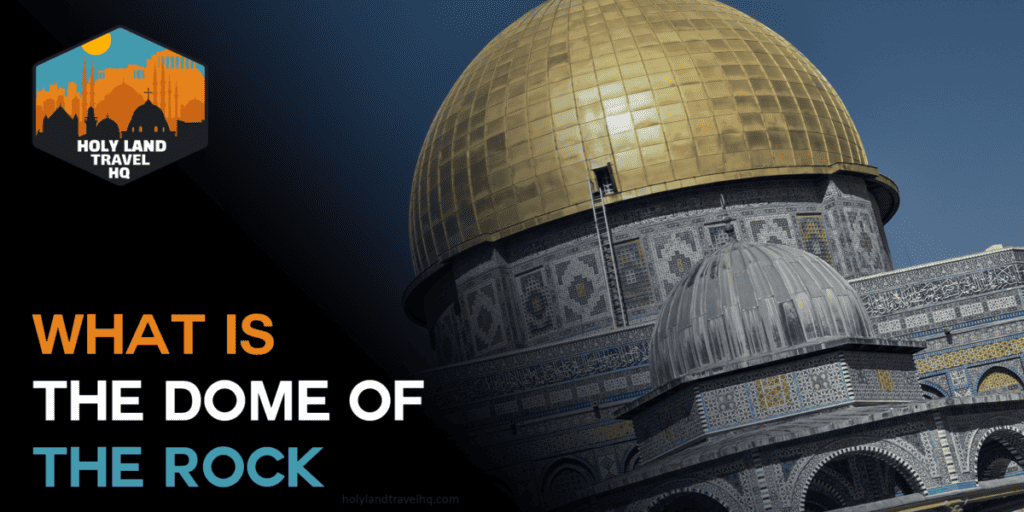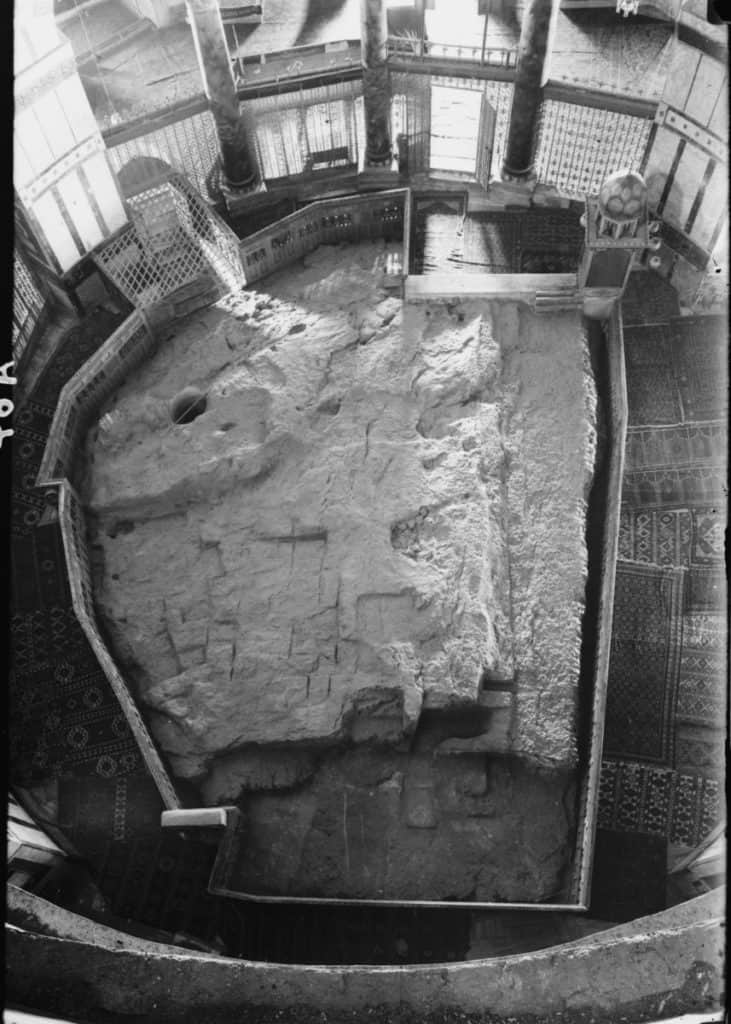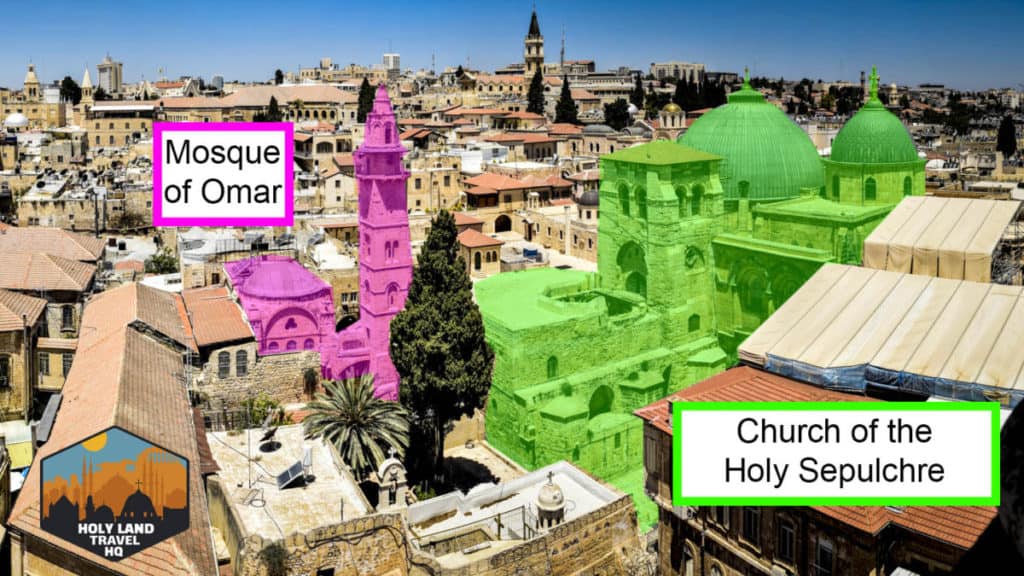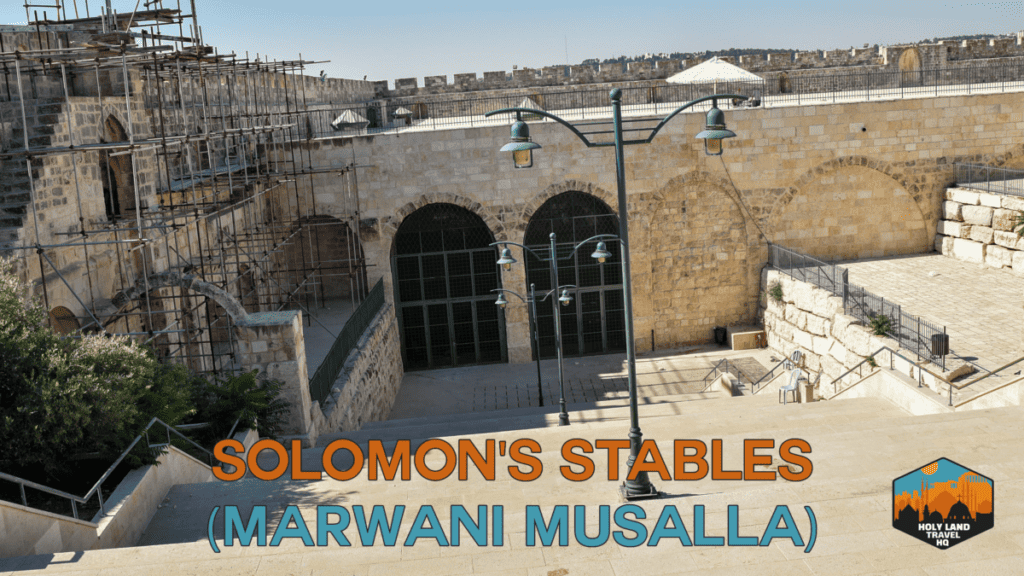
The modern Jerusalem skyline would be incomplete without the Dome of the Rock. It’s golden roof and colorful tile artistry make it a centerpiece for Jerusalem’s sprawling city. Despite its clear Muslim influence and purpose though, it is not a mosque like many casual observers surmise. So, what is the Dome of the Rock?
The Dome of the Rock is a Muslim shrine. It sits on the traditional location where Mohammad ascended to heaven on his night journey. The large piece of bedrock where he launched from is called the Foundation Stone. And the structure of the Dome surrounds it. Beneath the shrine is believed to be the ruins of the 2nd Jewish temple, which was destroyed by the Romans in 70 CE.
I say “believed to be” because we know the ruins are under there somewhere. But archaeologists haven’t had access to look around. On top of that, the foundation stone just looks like it was part of a former structure.

The Temple Mount, which encompasses the Dome of the Rock, the Al Aqsa Mosque, and the Western Wall has been the source of religious, cultural, and political strife for centuries now. And the temperature of that conflict doesn’t seem to be getting any cooler.

We previously looked at the Western Wall, in this post we’re going to look at the Dome of the Rock. Unfortunately, any discussion on the Dome and the Temple Mount, in general, is a political one. So, be prepared.
All links are direct.
Why was the Dome of the Rock Constructed?
Known as the Qubbat al-Sakhrah to Muslims, construction on the Dome of the Rock began in 691 CE and finished in 692 CE. So, about 55 years after Muslim forces captured Jerusalem.
Over the years, the Dome of the Rock has sometimes been incorrectly called the Mosque of Omar. The actual Mosque of Omar sits next to the Church of the Holy Sepulchre. We’ll get to this in a moment.
The Dome of the Rock is considered a shrine and is the oldest Muslim monument in existence. Scholars disagree over its original purpose though. Stories and documents saying that the Dome was erected to honor the location where Muhammad ascended into heaven for his night journey don’t show up until decades later.
Abd al-Malik, the Umayyad Caliph who ordered the project, most likely knew the location’s Islamic significance. However, markings inside the Dome appear to have another purpose.
Interior Arabic inscriptions inform visitors when the Dome was built. Further inscriptions specifically refute Christian theology by claiming Jesus was only a prophet and not God.
What can be said of the architecture of the Dome of the Rock?
The dome on the Dome of the Rock is 65 feet in diameter and sits 115 feet above its foundation. Comparatively, the dome on the Church of the Holy Sepulchre is 67.5 feet in diameter and sits 111 feet above its foundation.
Prior to the 1960s when the King of Jordan renovated the Dome of the Rock, the dome was covered in lead. Making it look exactly like the dome on the Church of the Holy Sepulchre.
The Architecture of the Dome of the Rock is clearly influenced by the octagonal design of Christian Byzantine churches. The most notable is the Church of the Seat of Mary, which is only 3 miles from the Temple Mount.
On Mount Gerazim, the ruins of an octagonal Byzantine church erected in the 5th century CE can be seen.
Needless to say, there were many influences in the city during the early Muslim occupation. Some scholars argue that the Dome of the Rock was not built to honor Muhammad’s night journey. But instead to combat the dominant Christian culture which thrived in the city.
No doubt, the early occupation force of Omar’s Rashidun army encountered stark resistance from the Christian and Jewish population.
Scholars who argue the Dome of the Rock is not a shrine to Muhammad’s night journey look towards 2 facts.
- The dome is almost identical to the dome on the Church of the Holy Sepulchre,
- An inscription inside the Dome of the Rock explicitly refutes Jesus’s claim to be the son of God.
These scholars argue that the Dome of the Rock was actually built to rival the Church of the Holy Sepulchre. And also, to sit at the highest point in the city to show Islam’s dominance over Christianity and Judaism.
Why didn’t Muslims just destroy the Church of the Holy Sepulchre?
When Muhammad died in 632 CE of illness, his lieutenant and father-in-law, Abu Bakr, took over leadership. What ensued was a 25-year period of military expansion of the Muslim world. In 634 CE, Abu Bakr fell ill and died. His successor was Omar.
In 636 CE, Omar’s Rashidun caliphate laid siege to Jerusalem during their war with the Byzantine Empire.
Shortly after the Rashidun Army began its campaign of Jerusalem, the Byzantines abandoned the city. Without better options, the patriarch of Jerusalem, Sophronius, looked to surrender. However, he stated that he would only surrender to Omar in person.
As part of the conditions of surrender in the Umariyya Covenant, Christians were allowed to worship freely. And Christian holy sites were to remain Christian.
When Omar arrived in Jerusalem, Sophronius gave him a tour of the Church of the Holy Sepulchre. Sophronius offered to lead Omar in prayer, but Omar refused. Instead, he opted to pray outside the church.
According to historians, Omar feared that praying in the church would establish a precedent for it as a place of Muslim worship. This would have broken the conditions of surrender. As well as endanger the church’s status as a Christian holy site.
Because of Omar’s decision not to pray inside the Church of the Holy Sepulchre, a precedent was set. But in the other direction. A mosque can never be built on the site. But this hasn’t stopped mosques from being built next to the church. Such is the case with the Mosque of Omar, which sits right next door.

Jerusalem is filled with Christian churches. The same was true in the 7th century. If you visit Israel, one thing you’ll notice is that the domes of the Church of the Holy Selupchre and the Dome of the Rock look like twins. Albeit the golden dome.
For more on the Church of the Holy Sepulchre, check out my post on it right here.
What is significant about octagonal Byzantine churches?
Christianity had a huge influence on Byzantine culture. Particularly because of Constantine’s interest in, and later conversion to, Christianity.
The octagonal shape of many Christian churches is not necessarily Christian, as much as it is Byzantine. In the Church of the Seat of Mary, the octagonal ruins surround a stone. Much like the Dome of the Rock does.
The Church of the Holy Sepulchre, which has similarities to an octagonal structure, surrounds the holy tomb of Christ.
Clearly, there was a point to the layout. Youtuber Religion for Breakfast states that the layout of the Dome of the Rock allows worshipers to walk in a circle around the rock. (Link is to his video on What is the Dome of the Rock? His video on an inside tour of the dome can be found right here.)
Why would Muslims use a Byzantine layout for a Muslim shrine? Maybe the point of the shrine was to appeal to Christians and Jews in an effort to show Muslim dominance. As well as conversion.
Other reasons the Temple Mount was chosen.
There is some textual evidence that suggests that Christians used the Temple Mount ruins as a garbage dump. Which would have made it an easy choice for a shrine. No one was using it and it sat higher than the city.
Although it is purely conjecture, it’s worth noting that there are some who believe the Temple Mount was not a garbage heap at all. That there was actually a Christian octagonal Byzantine church located there.
Some have even suggested that the Dome of the Rock was erected on the ruins of a former octagonal structure. Which Muslims believed to be where the Jewish temple once stood. And they chose the spot because of that information.
I bring this up for a reason. In 1996, the Waqf, the Islamic organization responsible for the Temple Mount began a large construction project. In an effort, they say, to make more room for worshipers, they cleared out the ground underneath the southern end. The area inside the Temple Mount known as Solomon’s stables.

The Waqf removed 9,000 tons of earth and dumped it on the side of the Kidron Valley. Controversy ensued and the Israeli government eventually was able to stop the digging. Archaeologists descended on the pile of rubble and began sifting through it.
What is known as the Temple Mount Sifting Project (direct link to website) has produced some very unique finds. Artifacts dating to the 6th and 7th century CE were discovered. Some of which elude to the existence of a Christian Church on the Temple Mount at the time. Rather than a garbage dump.
Other artifacts discovered include pieces from the 1st and 2nd temple periods.
The Waqf challenged the legitimacy of the artifacts since they were not found, conveniently, in situ. Or on location.
The Temple Mount has some history to it.
There is no denying that somewhere under the Dome of the Rock lies some pretty significant world and biblical history.
Muslims have occupied the land for the last 1,400 years. In 1967, during the 6-day war, the Temple Mount and East Jerusalem were taken from Jordan by the State of Israel. However, political tension eventually pushed the Israelis to let Muslim control continue. Through the Waqf.
If proof of Jewish history is found under the Temple Mount, any claim by Islamic rulers can be put in question. So, it behooves the Waqf to protect their claim.
Both sides seem to engage in political games in an attempt to invalidate the other. Or undermine the other’s movements to find or protect their claim.
In 1996, while the Waqf began its demolition under the Temple Mount, their lead archaeologist was conveniently away on assignment. Which allowed the Waqf plausible deniability that it was well planned.
The Waqf demolition was preceded earlier in the year by the opening of the Western Wall tunnels. Which caused an uproar and probably incited the Waqf project. Muslims charged that Israeli archaeologists were attempting to dig under the Dome of the Rock.
The excuses and secrecy from both sides have provided ample ammunition for distrust over the years. Though distrust has been the game for centuries.
After seeing the Western Wall tunnels myself, the consternation over them seems a bit overblown. But the digging could be true.
What’s at stake is the existence of evidence of prior ownership of the Temple Mount. It’s clear there was a Jewish temple at the location. And it would be interesting to see what’s down there.
Finding Balance.
Many of the websites I researched for this article made statements about the fine political balance the Temple Mount rests on. Religion for Breakfast calls it a “delicate political balance.” Joshua Hammer of the Smithsonian Magazine says, “The Temple Mount is precariously balanced between these opposing views.”
I don’t think there is any kind of balance surrounding the Temple Mount and Dome of the Rock at all. It’s a pile of kindling wood waiting for a spark to light it off.
The Waqf has to know what’s down there. It’s only a matter of time before the poker game comes to an end and shirt sleeves reveal hidden cards.
How is the Dome of the Rock Important to Christians?
The Temple Mount is important to all three Abrahamic religions. Obviously, Judaism and Christianity are much more aligned than Islam is with them.
For Christians, the Western Wall and Western Wall tunnels give us a glimpse into the world in which Jesus walked the Earth.
For centuries, Christians have looked to the New Testament for guidance. In that quest, we have tried to understand the 1st-century world in order to glean from the text its original meaning.
There is clearly more to the Dome of the Rock than what we see on the outside. The Byzantine era structure harkens back to a Jerusalem heavily influenced by Christianity. The conflict between the developing Christian culture and Judaism was interrupted by the rise of Islam.
The Dome of the Rock reflects this conflict.
This is important to our history because these events developed the theological discourse in meaningful ways.
Constantine’s reign politicized Christianity, but it also brought a new culture to it. The Church of the Holy Sepulchre sits as a testament to that effort today. The hubris of Byzantine Christianity gave way to larger religious-political structures in the western world, which then led to the Reformation.
Islamic conquests into the region of Roman Palestine and the Mediterranean brought challenges which believers answered. Despite your thoughts on the Crusades, they left an impact on our faith and Jerusalem.
Solomon’s stables were stables not because that’s where Solomon kept his horses, but because the crusaders kept their horses there.
The Temple Mount sifting project has produced crusader era artifacts. What else is down there? Writings? Imagine if we had a peek into the lives of some of those warriors. With their struggles and challenges.
How to Visit the Dome of the Rock.
There is one entrance to the top of the Temple Mount where non-Muslims can access the Dome of the Rock. It is through the Mughrabi Gate.
After an earthquake and heavy rain washed away the natural ramp in 2004, a wooden ramp was built to the gate. The entrance to the ramp is near the Dung Gate of the Old City to the south of the Western Wall.
You do not need an appointment, but you do need to dress appropriately.
Women need to cover their legs down below the knees. A dress, skirt, or pants will do. I would highly discourage leggings. Be mindful of the transparency of a skirt or dress. The Muslim guards at the top will take that into account. Also, women need to cover their shoulders. A sleeved shirt or shawl will do.
Men need to wear long pants that cover their legs down past their knees. A shawl can be used if you did not prepare for the day properly.
Bring your passport, but leave behind any Jewish or Christian sacred objects. Like crosses. Or anything that appears to be a cross.
During the class I took a few years ago, the instructor used a map of the Old City to point out some things. The map highlighted the boundaries of the 4 quarters of the Old City. Which essentially forms a cross. He was warned and threatened with permanent expulsion.
You are free to walk around the top. However, you cannot enter the Dome of the Rock, al-Aqsa Mosque, or Marwani Musalla (Solomon’s Stables).
The Mughrabi Gate is open to visitors Sunday through Thursday. Check the hours at the entrance, as times are subject to change.
Things to be aware of.
Jewish worshippers are allowed on the Temple Mount but are discouraged from doing so by rabbinic order. Because they don’t know exactly where the Holy of Holies once stood, a wandering Jew could inadvertently enter its space.
I am unsure, but I would surmise this uncertainty influenced the political decision in 1967 to leave control of the Temple Mount with the Waqf.
You may see Jewish worshippers walking the perimeter on the Temple Mount. They are allowed up there, but they have to be escorted by Israeli security guards. For their protection and to make sure they don’t do anything crazy. They aren’t allowed to pray or worship, but I’m sure some do secretly.
Members of extreme factions have been known to go up to the Temple Mount to “lay claim” by praying. In the Arab world, as in the story of Omar and Sophronius, committing the act of worship on a piece of land opens up the possibility of claiming it as a holy site.
If you do see Jewish worshippers there, you probably won’t see any drama from them. But you will definitely see other drama.
When a Jewish worshipper is being escorted on the Temple Mount, children, both boys and girls, are often sent to harass them. You will hear them screaming and shouting obscenities in an effort to break any religious concentration or focus.
It’s OK to look, but don’t linger or get involved. It’s not your fight.
References.
Here are some more references I used in writing this post. All links are direct.
- “What’s beneath the Temple Mount“ by Joshua Hammer of the Smithsonian magazine
- Dome of the Rock by Encyclopedia Britannica
- The Temple on Mount Gerizim by Megan Sauter of the Biblical Archaeological review
- The Dome of the Rock (Qubbat al-Sakhra) by The Khan Academy
- “How to visit the Temple Mount as a tourist” by Elaine of TheWholeWorldisaPlayground.com
- Visiting the Temple Mount and the Dome of the Rock by Touristisrael.com
- “What is the Dome of the Rock” video By Religion For Breakfast
- “What It’s Like Inside the Dome of the Rock” video By Religion For Breakfast


